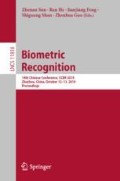Abstract
Sparse facial landmark localization has lower precision for face reconstruction, while more point landmarks are competent to depict the structure of facial components. In this paper, the pipeline of detecting 106-point facial landmarks with regression is proposed. Based on the convergence and practical application of multi-points regression, we design MobileNetV2-FL and VGG16-FL. Besides, an effective data preprocessing strategy and some training tricks, such as the Online Hard Example Mining algorithm and Wing loss are applied to the issue. Experimental results show that the proposed method has lower failure rate, and is an effective and robust facial landmark localization method.
Access this chapter
Tax calculation will be finalised at checkout
Purchases are for personal use only
References
Zhang, K., Zhang, Z., et al.: Joint face detection and alignment using multitask cascaded convolutional networks. IEEE Signal Process. Lett. 23(10), 1499–1503 (2016)
Sun, Y., Wang, X., Tang, X.: Deep convolutional network cascade for facial point detection. In: Proceedings of the IEEE Conference on Computer Vision and Pattern Recognition, pp. 3476–3483 (2013)
Zhou, E., Fan, H., Cao, Z., Jiang, Y., Yin, Q.: Extensive facial landmark localization with coarse-to-fine convolutional network cascade. In: Proceedings of the IEEE International Conference on Computer Vision Workshops, pp. 386–391 (2013)
Liu, Y., et al.: Grand challenge of 106-point facial landmark localization. arXiv preprint arXiv:1905.03469 (2019)
Bulat, A., Tzimiropoulos, G.: Binarized convolutional landmark localizers for human pose estimation and face alignment with limited resources. In: Proceedings of the IEEE International Conference on Computer Vision, pp. 3706–3714 (2017)
Trigeorgis, G., Snape, P., Nicolaou, M.A, et al.: A recurrent process applied for end-to-end face alignment. In: Proceedings of the IEEE Conference on Computer Vision and Pattern Recognition, pp. 4177–4187 (2016)
Bulat, A., Tzimiropoulos, G.: Super-FAN: integrated facial landmark localization and super-resolution of real-world low resolution faces in arbitrary poses with GANs. In: IEEE Conference on Computer Vision and Pattern Recognition, pp. 109–117 (2017)
Sagonas, C., Antonakos, E., et al.: 300 Faces In-The-Wild Challenge: database and results. Image Vis. Comput. 47, 3–18 (2016)
Sandler, M., Howard, A., et al.: MobileNetV2: inverted residuals and linear bottlenecks. In: IEEE Conference on Computer Vision and Pattern Recognition, pp. 4510–4520 (2018)
Simonyan, K., Zisserman, A.: Very deep convolutional networks for large-scale image recognition. arXiv preprint arXiv:1409.1556 (2014)
Liu, Z., Luo, P., et al.: Deep learning face attributes in the wild. In: Proceedings of the IEEE international Conference on Computer Vision, pp. 3730–3738 (2014)
Feng, Z. H., Kittler, J., et al.: Wing loss for robust facial landmark localization with convolutional neural networks. In: IEEE Conference on Computer Vision and Pattern Recognition, pp. 2235–2245 (2017)
Acknowledgments
This work is supported by National Science Foundation of China (No. 61573356) and National Key R&D Program of China (2018YFB0504900).
Author information
Authors and Affiliations
Corresponding author
Editor information
Editors and Affiliations
Rights and permissions
Copyright information
© 2019 Springer Nature Switzerland AG
About this paper
Cite this paper
Zhai, X., He, Y., Zhao, Q., Ding, Y. (2019). 106-Point Facial Landmark Localization with Mobile Networks Based on Regression. In: Sun, Z., He, R., Feng, J., Shan, S., Guo, Z. (eds) Biometric Recognition. CCBR 2019. Lecture Notes in Computer Science(), vol 11818. Springer, Cham. https://doi.org/10.1007/978-3-030-31456-9_32
Download citation
DOI: https://doi.org/10.1007/978-3-030-31456-9_32
Published:
Publisher Name: Springer, Cham
Print ISBN: 978-3-030-31455-2
Online ISBN: 978-3-030-31456-9
eBook Packages: Computer ScienceComputer Science (R0)

